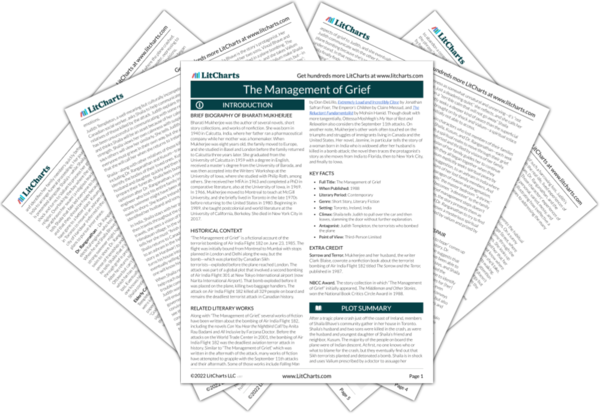When Judith initially asks for Shaila’s assistance, Shaila responds by saying that she won’t be able to help and that “we must all grieve in our own way.” Each person’s “own way” to grieve depends, the story suggests, on both their culture and their own personal, lived experience. For example, the Sikh couple maintains hope that their sons will return. Dr. Ranganathan finds refuge first in a kind of optimistic pragmatism and then by physically distancing himself from emotional tragedy by moving to Texas, where no one will know his story. Kusum moves to an ashram in Hardwar to pursue spiritual peace. Shaila seeks direction and wisdom in visions of her loved ones. By portraying the complexities of how grief is understood across different cultures, and the nuances of how people from the same culture perceive the same issues very differently, the story serves as a testament against the one-size-fits-all mentality advocated by Judith and the Canadian government. Instead, the story maintains the importance of trying to understand people as both influenced by their culture and their personal experiences, as an individual who must be taken on their own terms if someone wants to begin to understand them or enter into meaningful communication with them.
Navigating Cultural Difference ThemeTracker

Navigating Cultural Difference Quotes in The Management of Grief
The Management of Grief Quotes
Dr. Sharma, the treasurer of the Indo-Canada society, pulls me into the hallway. He wants to know if I am worried about money. His wife, who has just come up from the basement with a tray of empty cups and glasses, scolds him. “Don’t bother Mrs. Bhave with mundane details.”
“Nothing I can do will make any difference,” I say. “We must all grieve in our own way.”
“It’s a parent’s duty to hope,” [Dr. Ranganathan] says. “It is foolish to rule out possibilities that have not been tested. I myself have not surrendered hope.”
[My mother] grew up a rationalist. My parents abhor mindless mortification.
The zamindar’s daughter [my grandmother] kept stubborn faith in Vedic rituals; my parents rebelled. I am trapped between two modes of knowledge… like my husband’s spirit, I flutter between worlds.
“In the textbooks on grief management,” [Judith] replies—I am her confidante, I realize, one of the few whose grief has not sprung bizarre obsessions—“there are stages to pass through: rejection, depression, acceptance, reconstruction.” She has compiled a chart and finds that six months after the tragedy, none of us still reject reality, but only a handful are reconstructing. “Depressed Acceptance” is the plateau we’ve reached.
“God provides and God takes away,” he says.
I want to say, But only men destroy and give back nothing. “My boys and my husband are not coming back,” I say. “We have to understand that.”
Now the old woman responds. “But who is to say? Man alone does not decide these things.” To this her husband adds his agreement.











